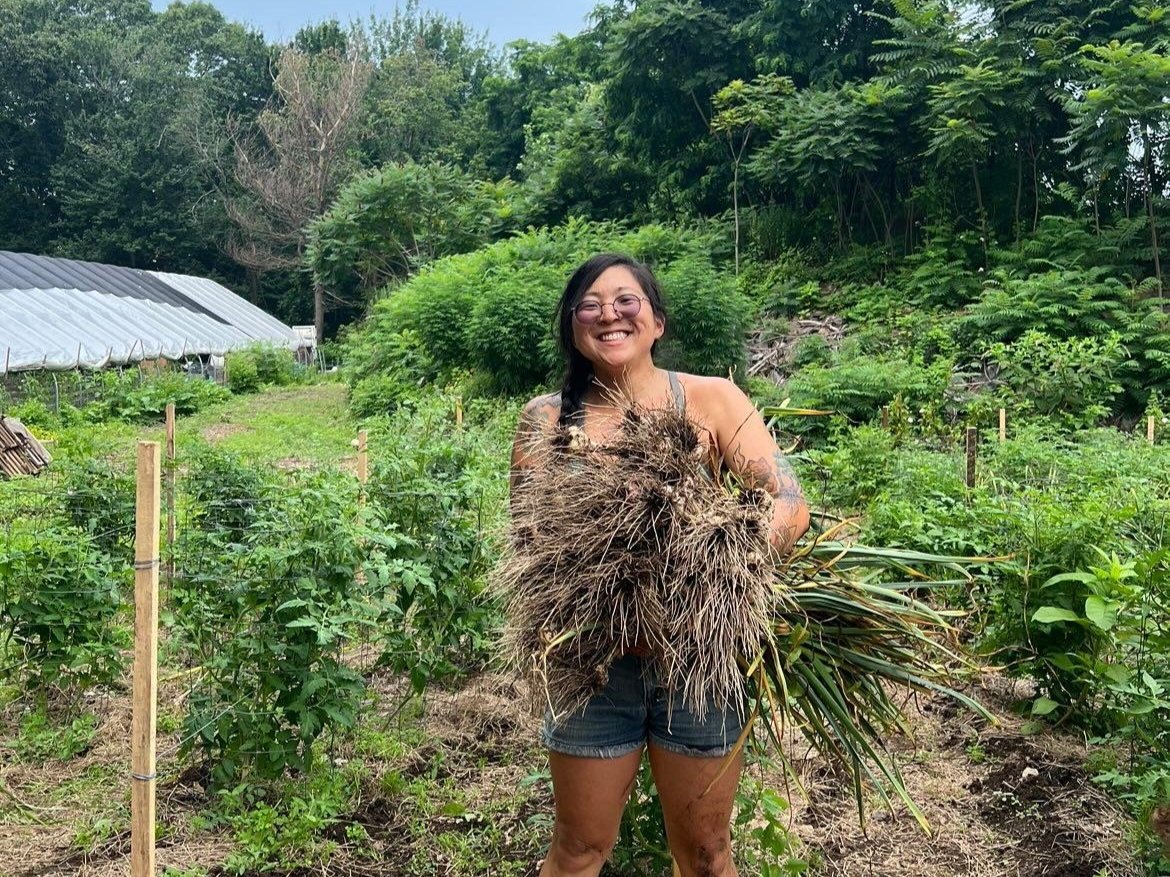What Do Garlic and Cannabis Have in Common?
We asked a stoner scientist for the facts
Miyabe harvesting garlic at Maitland Mountain Farm, photo credit Miyabe Shields
My hands are covered with a dried chalky white sheen as I finish harvesting thousands of garlic scapes when a strong wave of emotions overcome me. I have alexithymia, which means I struggle to name and identify what I’m feeling, so I begin my process for finding the name of this foreign emotion, lest it be the type to consume me.
I planted this field of garlic on one of my first days at the farm. As I placed each clove into the earth, I felt like I was burying my old life with them, giving all my old intentions back to the earth. I had just stepped down as Chief Scientific Officer of a cannabis research startup I co-founded, and I was hurting. I was disappointed to my core. But as I plunged each clove an inch into the soil, pointed-tip upwards, I began to feel lighter. Each of these garlic cloves would bring a new, therapeutic life with them, and perhaps so would I.
Garlic as Medicine
Garlic is one of humanity’s most ancient medicines; humans have been cultivating garlic for food and medicine for thousands of years. I use garlic, but I never knew it takes all four seasons to grow the garlic plant. The single cloves planted in late fall need to prepare through the winter, gather energy in the spring, and return that energy back to creating more cloves in the earth through the summer until harvest in early fall. This lengthy cycle is rooted in the complex chemistry that we enjoy in garlic’s distinctive smell and taste and is an example of nature’s creative ability. Garlic’s antimicrobial, antioxidant, anticancer, and anti-diabetic activity has been linked to the sulfurous compounds within⁽¹⁾.
Garlic and the Endocannabinoid System
When you bite into a raw clove of garlic, there is a spicy tingle that accompanies the flavor. This spiciness comes from the activation of an endocannabinoid target, the TRPV1 receptor⁽²⁾ also known as the spicy receptor. This receptor is not only responsible for sensing spiciness, but also heat, acidity, and other important chemical messengers in the brain and body like anandamide, the endocannabinoid that interacts with our CB1 receptors in a similar way to THC⁽³⁾. The TRPV1 receptors play an important role in sensing pain, and are found not just on our taste buds, but in our brain as well.
But it’s not just the endocannabinoids that activate the TRPV1 receptor. Cannabinoids like CBD and CBG have been shown to activate the TRPV1 receptor⁽⁴⁾ and there’s early evidence that there’s cross-talk between the TRPV1 and CB1 receptors⁽⁵⁾, which means activation of one or both receptors can change the signaling of the other. This is one of the challenges in classifying and identifying specific strains or formulations of cannabis for desired therapeutic effects: We each have our own unique receptors and systems which are met with an equal amount of complex variables from cannabis.
Cannabis and Garlic
Cannabis can be earthy, spicy, and pungent with a lingering taste reminiscent of garlic, like the strains Garlic Juice or GMO (Garlic, Mushroom, and Onion). While we usually only think of the terpenes as responsible for creating the aroma and entourage effect in cannabis, there’s an entirely different class of sulfurous molecules that play a role in how we perceive cannabis, and these compounds are similar to those found in garlic.
The sulfur is responsible for giving off cannabis’ distinctive “skunk-like” smell, and there have been two identified molecules in cannabis that are extremely similar in structure to allicin, the active molecule in garlic⁽⁶⁾. It’s way too early to say that eating garlic will change the effects of cannabis, but it is quite possible that the sulfurous compounds in cannabis that are similar to garlic may contribute to unique strain-specific effects when these compounds are present.
The entourage effect, or the combined experience of all the different molecules that are in cannabis, is much larger and more varied than just the cannabinoids and terpenes. There are hundreds of unique molecules in cannabis, which means that there are millions upon millions of combinations of those molecules at different ratios in different strains, preparations, and consumption methods that can create unique effects. It’s one of the reasons many of us have a favorite consumption method and a personal preference for the general aroma of our cannabis. The enjoyment of these subtle differences is rooted in an appreciation for how nature can create unique experiences and flavors as a result of the combination of different molecules.
Garlic scapes and mushrooms at Maitland Mountain Farms. PHOTO: Miyabe Shields
Food as Medicine
Foods and natural medicines from the earth are rich in diversity, and as a pharmaceutical scientist, I was trained to appreciate them as a source of new molecules to be traced and replicated synthetically, with slight alterations, so that they would be patentable and made profitable.
So as I licked the chalky white, sulfurous substances from harvesting the garlic scapes off my hands, I identified the overwhelming emotions I’d been feeling. One was love. I love the earth’s capacity for creation, its vast and magnificent chemistry. And there was pride. I am proud of what I have contributed to this growth that will go back to my community. Finally, there was hope. I hope I can help change our perception of the scientific basis of what makes the ideal medicine.
There are unknowns in the chemodiversity of natural medicines, but there is also unknown potential. If anyone wants to do a controlled study with a garlic and cannabis preparation for gastrointestinal issues, please reach out.
References:
Mohammad Shafiur Rahman (2007) Allicin and Other Functional Active Components in Garlic: Health Benefits and Bioavailability, International Journal of Food Properties, 10:2, 245-268, DOI: 10.1080/10942910601113327
Macpherson, L. J., Geierstanger, B. H., Viswanath, V., Bandell, M., Eid, S. R., Hwang, S., & Patapoutian, A. (2005). The pungency of garlic: activation of TRPA1 and TRPV1 in response to allicin. Current biology : CB, 15(10), 929–934. https://doi.org/10.1016/j.cub.2005.04.018
Benítez-Angeles, M., Morales-Lázaro, S. L., Juárez-González, E., & Rosenbaum, T. (2020). TRPV1: Structure, Endogenous Agonists, and Mechanisms. International journal of molecular sciences, 21(10), 3421. https://doi.org/10.3390/ijms21103421
Muller, C., Morales, P., & Reggio, P. H. (2019). Cannabinoid Ligands Targeting TRP Channels. Frontiers in molecular neuroscience, 11, 487. https://doi.org/10.3389/fnmol.2018.00487
Wi, R., Chung, Y. C., & Jin, B. K. (2020). Functional Crosstalk between CB and TRPV1 Receptors Protects Nigrostriatal Dopaminergic Neurons in the MPTP Model of Parkinson's Disease. Journal of immunology research, 2020, 5093493. https://doi.org/10.1155/2020/5093493
Oswald, I. W. H., Ojeda, M. A., Pobanz, R. J., Koby, K. A., Buchanan, A. J., Del Rosso, J., Guzman, M. A., & Martin, T. J. (2021). Identification of a New Family of Prenylated Volatile Sulfur Compounds in Cannabis Revealed by Comprehensive Two-Dimensional Gas Chromatography. ACS omega, 6(47), 31667–31676. https://doi.org/10.1021/acsomega.1c04196
Dr. Miyabe Shields, PhD is a queer, neurodivergent, stoner scientist and an avid psychonaut. After cannabis positively changed their ability to relate to others at the age of 15, Miyabe dedicated their life to understanding the inner workings of the neurodivergent brain on drugs. Miyabe went from academic research in pharmaceutical sciences specializing in drug discovery in the endocannabinoid system to rare extract and formulation research in the cannabis industry, embracing the thrill of pushing scientific boundaries. But due to other boundaries, Miyabe grew to be incompatible with both academic and industrial research settings.
Now a beginner farmer immersing themself in urban agriculture as a community health initiative, Miyabe hopes to facilitate change through creating authentic, accessible scientific education content, protocols, and experiences that lower barriers to health equity. Follow her work at Project Chronic.





